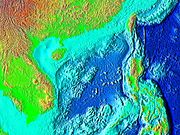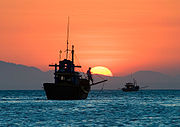
South China Sea
Background Information
This Wikipedia selection is available offline from SOS Children for distribution in the developing world. A good way to help other children is by sponsoring a child
| South China Sea | |||||||||||
|---|---|---|---|---|---|---|---|---|---|---|---|
 |
|||||||||||
| A map of the South China Sea | |||||||||||
| Chinese name | |||||||||||
| Traditional Chinese | 南中國海 | ||||||||||
| Simplified Chinese | 南中国海 | ||||||||||
| Hanyu Pinyin | Nán Zhōnggúo Hǎi | ||||||||||
|
|||||||||||
| Vietnamese name | |||||||||||
| Vietnamese | Biển Đông | ||||||||||
| Malay name | |||||||||||
| Malay | Laut China Selatan | ||||||||||
| Filipino name | |||||||||||
| Tagalog | Timog Dagat Tsina ('Dagat Luzon' for the portion within Philippine waters) | ||||||||||
| Portuguese name | |||||||||||
| Portuguese | Mar da China Meridional | ||||||||||
The South China Sea is a marginal sea south of China. It is a part of the Pacific Ocean, encompassing an area from Singapore to the Strait of Taiwan of around 3,500,000 km². It is one of the largest sea bodies after the five oceans. The minute South China Sea Islands, collectively an archipelago, number in the hundreds. The sea and its mostly uninhabited islands are subject to several competing claims of sovereignty by neighboring nations. These competing claims are also reflected in the variety of names used for the islands and the sea.
Names for the sea

South China Sea is the dominant term used in English for the sea, and the name in most European languages is equivalent, but it is sometimes called by different names in neighboring countries, often reflecting historical claims to hegemony over the sea.
The English name is a result of early European interest in the sea as a route from Europe and South Asia to the trading opportunities of China. In the sixteenth century Portuguese sailors called it the China Sea (Mare da China); later needs to differentiate it from nearby bodies of water led to calling it the South China Sea.
In China, the traditional name for the sea is Southern Sea (南海; Nán Hǎi). In contemporary Chinese publications, it is commonly called South China Sea (南中國海, Nán Zhōnggúo Hǎi), and this name is often used in English-language maps published by China.
In Vietnam, it is called the Eastern Sea (Biển Đông); this name is sometimes used by Vietnamese mapmakers in foreign-language publications.
The part of the South China Sea within Philippine territorial waters is often given the name "Luzon Sea" (Dagat Luzon) in maps published in the country, after the major Philippine island of Luzon. However, the name "South China Sea" (Timog Dagat Tsina) is still the accepted name for the whole sea in the Philippines.
In Southeast Asia, it was once called the Champa Sea or Sea of Cham, after the maritime kingdom that flourished before the sixteenth century.
Geography
The International Hydrographic Organization defines the sea as stretching in a southwest to northeast direction, whose southern border is 3 degrees South latitude between South Sumatra and Kalimantan ( Karimata Strait), and whose northern border is the Strait of Taiwan from the northern tip of Taiwan to the Fujian coast of mainland China. The Gulf of Thailand covers the western portion of the South China Sea.
The sea lies above a drowned continental shelf; during recent ice ages global sea level was hundreds of meters lower, and Borneo was part of the Asian mainland.
States and territories with borders on the sea (clockwise from north) include: the mainland China, Macau, Hong Kong, Taiwan, the Philippines, Malaysia, Brunei, Indonesia, Singapore, Thailand, Cambodia, and Vietnam.
Major rivers that flow into the South China Sea include the Pearl, Min, Jiulong, Red, Mekong, Rajang, Pahang, and Pasig Rivers.
Geology
The South China Sea opened after around 45 million years ago when the Dangerous Grounds were rifted away from southern China. Extension culminated in seafloor spreading around 30 million years ago, a process that propagated to the SW resulting in the V-shaped basin we see today. Extension ceased around 17 million years ago. Arguments have continued about the role of tectonic extrusion in forming the basin. Paul Tapponnier and colleagues have argued that as India collides with Asia it pushes Indochina to the SE. The relative shear between Indochina and China caused the South China Sea to open. This view is disputed by geologists who do not consider Indochina to have moved far relative to mainland Asia. Recent marine geophysical studies by Peter Clift has shown that the Red River Fault was active and causing basin formation at least by 37 million years ago in the NW South China Sea, consistent with extrusion playing a part in the formation of the sea. Since opening the South China Sea has been the repository of large sediment volumes delivered by the Mekong River, Red River and Pearl River. Several of these deltas are rich in oil and gas deposits.
Islands and seamounts
Within the sea, there are over 200 identified islands and reefs, most of them within the Spratly Islands. The Spratly Islands spread over an 810 by 900 km area covering some 175 identified insular features, the largest being Taiping Island (Itu Aba) at just over 1.3 km long and with its highest elevation at 3.8 metres.
The largest singular feature in the area of the Spratly Islands is a 100 km wide seamount called Reed Tablemount, also known as Reed Bank, in the northeast of the group, separated from Palawan Island of the Philippines by the Palawan Trench. Now completely submerged, with a depth of 20 m, it was an island until it sunk about 7,000 years ago due to the increasing sea level after the last ice age. With an area of 8,866 km², it is one of the largest submerged atoll structures of the world.
Territorial claims
Competing territorial claims over the South China Sea and its resources are numerous. Because the 1982 United Nations Law of the Sea allows for a country's Exclusive Economic Zone (EEZ) to extend 200 nm (370.6 km) beyond territorial waters, all the nations surrounding the sea can lay claim to great portions of it. The People's Republic of China (PRC) has stated its claim to almost the entire body. Areas with potential problems include:
- Indonesia and the PRC over waters NE of the Natuna Islands.
- The Philippines and the PRC over the Malampaya and Camago gas fields.
- The Philippines and the PRC over Scarborough Shoal.
- Vietnam and the PRC over waters west of the Spratly Islands. Some or all of the islands themselves are also disputed between Vietnam, the PRC, the ROC, Brunei, Malaysia, and the Philippines.
- The Paracel Islands are disputed between the PRC/ROC and Vietnam.
- Malaysia, Cambodia, Thailand and Vietnam over areas in the Gulf of Thailand.
- Singapore and Malaysia along the Strait of Johore and the Strait of Singapore.
The PRC and Vietnam have both been vigorous in prosecuting their claims. The Paracel Islands was seized by China in 1974 and 18 soldiers were killed. The Spratly Islands have been the site of a naval clash, in which over seventy Vietnamese sailors were killed just south of Chigua Reef in March 1988. Disputing claimants regularly report clashes between naval vessels.
ASEAN in general, and Malaysia in particular, has been keen to ensure that the territorial disputes within the South China Sea do not escalate into armed conflict. As such, Joint Development Authorities have been setup in areas of overlapping claims to jointly develop the area and dividing the profits equally without settling the issue of sovereignty over the area. This is true, particularly in the Gulf of Thailand.
The overlapping claims over Pedra Branca or Pulau Batu Putih by both Singapore and Malaysia has been brought to the International Court of Justice and the public portion of the case was heard over November 6-23, 2007, a decision is expected in 2008.
Competing territorial claims over the South China Sea and its resources are numerous. Because the 1982 United Nations Law of the Sea allows for a country's Exclusive Economic Zone (EEZ) to extend 200 nm (370.6 km) beyond territorial waters, all the nations surrounding the sea can lay claim to great portions of it. The People's Republic of China (PRC) has stated its claim to almost the entire body. Areas with potential problems include:
* Indonesia and the PRC over waters NE of the Natuna Islands. * The Philippines and the PRC over the Malampaya and Camago gas fields. * The Philippines and the PRC over Scarborough Shoal. * Vietnam and the PRC over waters west of the Spratly Islands. Some or all of the islands themselves are also disputed between Vietnam, the PRC, the ROC, Brunei, Malaysia, and the Philippines. * The Paracel Islands are disputed between the PRC/ROC and Vietnam. * Malaysia, Cambodia, Thailand and Vietnam over areas in the Gulf of Thailand. * Singapore and Malaysia along the Strait of Johore and the Strait of Singapore.
The PRC and Vietnam have both been vigorous in prosecuting their claims. The Paracel Islands was seized by China in 1974 and 18 soldiers were killed. The Spratly Islands have been the site of a naval clash, in which over seventy Vietnamese sailors were killed just south of Chigua Reef in March 1988. Disputing claimants regularly report clashes between naval vessels.
ASEAN in general, and Malaysia in particular, has been keen to ensure that the territorial disputes within the South China Sea do not escalate into armed conflict. As such, Joint Development Authorities have been setup in areas of overlapping claims to jointly develop the area and dividing the profits equally without settling the issue of sovereignty over the area. This is true, particularly in the Gulf of Thailand.
The overlapping claims over Pedra Branca or Pulau Batu Puteh by both Singapore and Malaysia has been brought to the International Court of Justice and the public portion of the case was heard over November 6-23, 2007. On the 5-23-2008 the International Court of Justice ruled in favour of Singapore. Pedra Branca/Pulau Batu Puteh is now officially under the sovereignty of Singapore.
